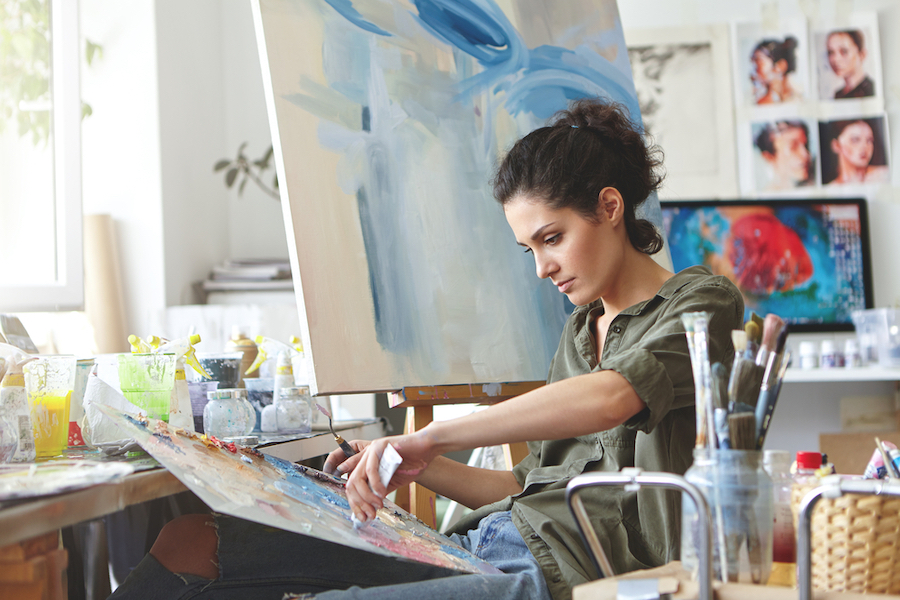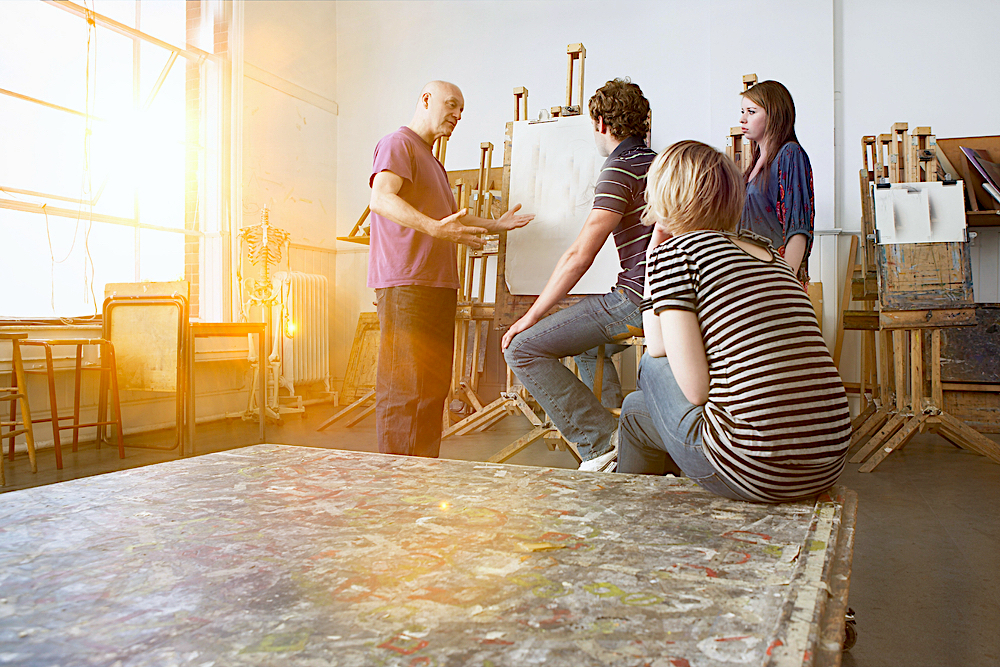Spring rolling into the Christmas season, for most makers, means open studio time. It’s also the time of year when makers experience most of their sales, which will see them through the down months for the year to come.
So while open studios can be a lot of work – and will not always feel like the right fit, if you are more of a solitary maker – they can be worth the push.
Whether you are opening your doors as part of a local Art Trail, as a collaborative event among a studio complex, or just going it alone, getting the set-up right to maximise the opportunity is key.
Here, ArtsHub steps you through a checklist of things to consider.
Thinking ahead and starting early
1. Timing
Obviously, timing is everything. Art Trails tend to be scheduled in the spring and summer months, but take an annual approach. Plan what your capacity is to make enough stock for these events, and get organised early. Look at local events to tap into to maximise an audience and awareness, and always check more general calendars for clashes.
2. Determine what it is you want to achieve
What are you hoping to get out of your open studio event? Is it sales primarily and, if so, what target do you hope to achieve?
Are you wanting to build awareness and get people to sign up to your newsletter and social channels? Or are you wanting to use the opportunity to launch a new range or series?
Could it be a catalyst to build up workshop attendance for the year ahead – a kind of teaser to hook people’s interest?
Whatever that goal is, think it through and be sure to track it so you can determine whether the ‘open studio’ exercise is successful enough for you to warrant continued pursuit.
3. Lock your support network in
Often makers get everything ready – marketing, production, packaging – but get to the week before and realise, “Hey, I am not going to be able to manage all these people on my own!”
Lock your network in early. Do you need an assistant and is that a friend, or do you pay someone? Allow time to brief them on your sales system and your work. They can also do that vital point of sale follow-up for contact details for you. What this does is free you up to talk to visitors, which can equate to business – be it a sale on the day, a follow-up online sale, or workshop. It’s also a security bonus to have an extra set of eyes across things, especially when busy.
Next, check in with your friends and see if they can visit at different blocks of time, to ensure there is a ‘buzz’ in the space.
4. Get your orders in early
Signage to direct people into the space is vital – this may be an outdoor flag, A-frame signs, pull up banners, or street ‘spike signs’ that lead visitors to your door. This all takes time to design and print. Services like Canva and Vistaprint make if very easy to do this today without costing too much.
Advise the local tourism and council offices early so they can add you to their free community calendars.

Think through how you are going to package things on the day; do you need wrapping materials or carry bags? Do you have plenty of business cards that people can take with them to follow up on items, share with a friend and contact you later?
And if you have gallery representation, don’t forget to let them know you are participating in an Open Studios event, and confirm what your contractual obligations are regarding sales from your studio.
5. Start making early
Sales means things to buy – which means having plenty of stock at varying price points. Think this through early and plan what you intend to offer, and then work out a realistic making schedule to pace yourself up to your open day.
This also means considering whether you have enough supplies and product packaging to make those things (stock orders are still slow, so you need to take this into account).
The last thing you want to do is be up to midnight every day the week prior still trying to make stock. Pick a day to stop making so you can start on the rest of the process.
6. Insurance: yes, you need it
Get contents/liability insurance sorted, if necessary. Most artists’ organisations offer studio liability cover through their memberships.
Mood, moment and marketing
1. Flow and feel
What is the energy you want to create in the space? Some background music is a good idea. Why not consider creating a playlist that captures your personality – you can even share it with a QR code.
Think about people physically moving about your space (make sure it’s free of tripping hazards) and where their eyes will go. Make sure there is ventilation and good light. Plants are good to soften the space, and perhaps think of imagery and information – if you are not set up for demonstrations, then think about blowing up some large images of you working so visitors can connect with that making experience. Alternatively, you can leave a ‘staged set-up’ of your working area.
And declutter as much as possible; it is amazing what you can hide under a sheet, or under a cloth-draped table, to keep the eye focused on the work rather than studio mess.
Think about kids – they will come with their parents, so do a “safety sweep” of your space.
If you are a maker – a ceramicist, jeweller, textile or glass artist, for example – you need to think more rigorously about display. Creating height and levels to display pieces along your trestle table makes for a better viewing experience. A warning, however: beware of towering wobbly displays or lots of crumpled fabric as they can lead to breakages.
And don’t show everything. You are better off replenishing and rotating – make sure you have back up stock ready! – rather than confusing people with too many options. That usually ends with them walking away even though they want to buy something.
2. Marketing: the verbal kind
Artists are notorious for saying they don’t like talking about their work. However, open studios are all about that – connecting people with you. Big tip – just be yourself. You don’t need to “sell” your work; being genuine will do that.
Remember that people are interested; that’s why they are there. They know they are at an artist’s studio so they don’t expect a “show”. That said, it is still good to prepare your elevator pitch. Just think of the three key things about your making: how you make it, why you make it and a story – how long you have had the studio/been an artist, whether this is your first time to host an open studio, etc.
The conversation will just casually flow from there.
And before the event, talk it up at every opportunity. Why not keep an digital invitation on your phone so you can easily AirDrop when talking? People are notoriously bad at following up themselves, but if they have the details they are more likely to lock it in.
3. Marketing: the visual kind
Unless people know about your open studio, they won’t come. This is the greatest challenge when you are not part of an Art Trail group.
Use your social media channel, and build up those ‘save the day’ announcements; also, trickle teasers from about 10 days leading in. Don’t leave it to the day to say your doors are open. Consider doing some stories or reels on the day to capture the buzz.
Read: Being a studio assistant has ‘opened up my mind set’
Use your mailing list and invite everyone – encourage them to bring their friends. Speak to the local radio station – they love events like this – and post on community noticeboards.
If you are in a building with many artists a door sign with your name and contact details is useful for people to find you.
And if you are part of an Art Trail, buddy up with a couple of the other studios as a ‘reference group’, each of you recommending the other as the best next visit on the trail.
4. Sustenance
Will you offer refreshments? I’d advise not. It is an added expense and tricky today with food allergies. You could do a VIP preview an hour prior to the general opening (or night before) with an RSVP if you want to make it that kind of event.
However, be sure to pack an ‘in studio picnic’ for the day. You will be too busy to do anything on the day, and a ‘back in 5 minutes’ sign on the door just undoes all the good work you have done. Most importantly, hydrate, hydrate, hydrate.
You may want to think about partnering with a coffee cart or local winery – they shoulder the costs and it is a win-win in building a visitor experience.
Understand your pricing
Price everything – and stick to it. Be clear beforehand if you will offer a discount and what that will be. Remember: this is an open studio not a fire sale; respect your practice.
Create a price list. Often people are shy about asking, so ensure prices are bold and visible, and that those price lists are scattered around. Keep one at your point of sale.
Remember to have something ‘cheaper’ for people to buy – this may be greeting cards or small prints of your work, for example. Largely, people want to support you, but they can’t always afford the top drawer works on show. Such small sale items are also a great way to offset some of the costs of staging the open studio event.
Work out how you will receive money from people. Today, Square integration is the easiest with 95% of people preferring to pay digitally.
From experience, I have found that only about 20% of people want a receipt on the day, and this can easily be managed through your Square terminal.
And if you want to be super professional, do a one-page flyer with an artist statement on the front and a written bio on the back, complete with a picture of the studio and your work as a trigger memory. This is great to have a copy to give to people with purchases so they have something for their records.
Don’t forget to document the work in case it sells. And also document the buyer – make sure you get all your new collector’s contact info.
If you want to learn more consider, reading Melinda Cootsona‘s book Open Your Studio: Nine Steps to A Successful Art Event, which has been a #1 bestseller on Amazon. She says that ‘Getting the right price for your art is a big key to your sales, so take a deep breath and begin to look at your work objectively.’
Tips for the day
Be genuine – people are there because they are curious to see what you do. But also avoid being monopolised; this can happen easily at open studios.
Think of something you can work on in the down times, or with small numbers in the space, that you can easily pick up and put down. This has two benefits: people can see your working process and it can relieve the anxiety of slow times.
Pace yourself – it’s OK to take a breather and sit down.
Enjoy. Of all the open studios I have run, I have never not made money; I have never walked away saying “well, that was a bad idea”; and I have always grown my circle of support, with new collectors and followers sincerely signing on.
But, it doesn’t end on the day
The secret to any good business is building relationships. Use your social channels, website and mailing list to thank people for coming and offer a brief report on the day.
Debrief as soon as it is over – within a day or two – with a few notes: what sold, what were people most asking; what did you get wrong: what really worked well. This will be golden information for the next time you open your doors.
Save your signage – recycle and reuse!
Follow up on any commissions, workshop enquiries etc and give them a sense of timing and outcomes from their interest. For example, you may like to say that, given the interest in workshops on the day, you are currently working on an offering to roll out in the next six months.
And mostly, relax now. Why not book a massage for the day after as a reward?




